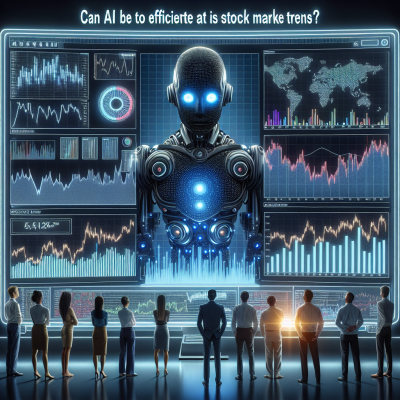
AI’s Growing Clout in Stock Market Analysis
Artificial Intelligence (AI) is transforming the financial world at a pace faster than many anticipated. From high-frequency trading bots to portfolio optimization systems, AI is redefining how traders and institutions interpret market trends. But a pressing question is beginning to surface: Is AI becoming too efficient at tracking and predicting stock market behavior?
The Rise of AI in Financial Markets
AI and machine learning models have been integrated into the financial ecosystem over the past decade. However, recent advancements have made these systems far more precise, accessible, and influential. Institutional investors and individual traders alike are turning to AI-driven platforms not just for support—but for critical decision-making.
Some of the most advanced algorithms can now scan global news articles, analyze investor sentiment, digest economic reports, and generate real-time trading signals. The result? Faster and arguably smarter investment choices.
Predictive Models That Learn and Adapt
Today’s AI-powered investment platforms are not static tools. They continuously learn and adapt based on new patterns and variables. Leveraging deep learning and neural networks, these tools can:
- Analyze vast amounts of historical stock data
- Predict short- and long-term movements in equity markets
- Spot anomalies and alert traders before human analysts can react
This ability to analyze with speed and accuracy has shifted the competitive edge substantially in favor of those with access to such sophisticated platforms.
Are We Approaching AI Over-Optimization?
While the benefits are undeniable, experts are beginning to debate whether AI may become too efficient at identifying trade signals. When too many investors rely on similar models, there’s a risk of “crowding”—where everyone ends up on the same side of a trade. This could potentially increase market volatility or reduce the availability of high-yield investment opportunities.
Moreover, algorithmic trading can sometimes cause flash crashes or unpredictable market swings. AI systems act on logic and pattern recognition; they don’t consider broader economic or geopolitical impacts the same way a human analyst might.
The Democratization of AI-Driven Investing
More platforms are offering AI capabilities to everyday investors. This democratization is fueled by tools that provide retail traders with real-time analysis, trade recommendations, and even auto-execution features.
While this levels the playing field to some extent, it also raises questions about market saturation with AIs using similar strategies. If everyone has access to the same insights, will any one investor still be able to outperform consistently?
The Regulatory Perspective
Regulators are also scrutinizing the growing dependence on AI for financial decisions. The concern is not just about trading risk but about transparency. AI systems often operate as black boxes—producing results without clearly outlining the logic behind them. This makes it difficult for investors, managers, and regulators to understand root causes when issues arise.
There’s increasing demand for “explainable AI” in finance—a version of these tools that offers clear reasoning behind trade suggestions or analytics. As of now, many firms operate in a grey area when it comes to transparency and compliance.
What This Means for Investors
For investors, AI offers unprecedented tools for market navigation. However, it’s important to maintain a balanced perspective. Over-reliance on automated recommendations could lead traders to overlook longer-term fundamentals or irrational market behaviors.
Here are a few tips for smart AI use:
- Validate AI signals with human judgment: Use AI as a tool, not a crutch.
- Diversify strategies: Don’t put all your eggs in one digital basket.
- Stay informed about the underlying tech: Understand how your AI model works.
The Future of AI in Trading: Assistive, Not Autonomous
While it’s tempting to imagine a future where trades are entirely AI-driven, the realistic path forward lies in collaboration. Human intuition combined with AI precision can create a hybrid model that leverages the strengths of both.
AI is a tool—an incredibly powerful one—but like all tools, its effectiveness depends on how it’s used. As these systems become more robust and widely adopted, the smart investor will be the one who doesn’t just follow AI but partners with it.
Conclusion
So, is AI too good at tracking stock market trends? Perhaps. But whether that’s a threat or an opportunity depends on how we wield this power. As with all technological revolutions, success will come to those who adapt—thoughtfully and strategically.
The financial markets are changing, and AI is at the helm. The question now isn’t if AI will become the standard—it’s how investors will evolve alongside it.


Leave a Reply